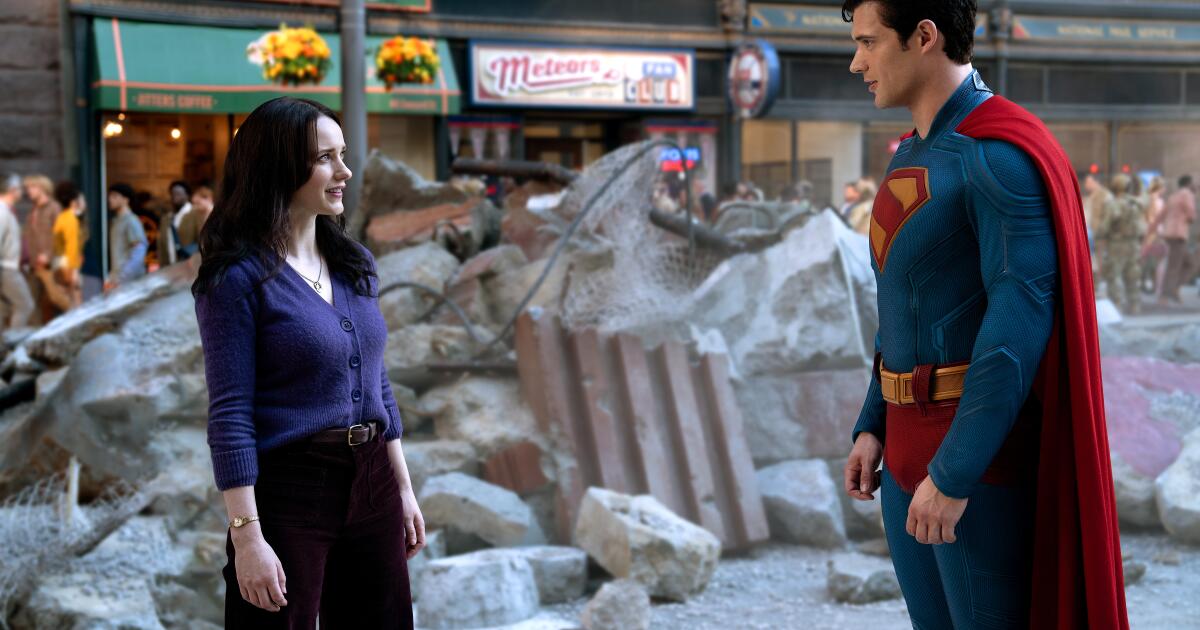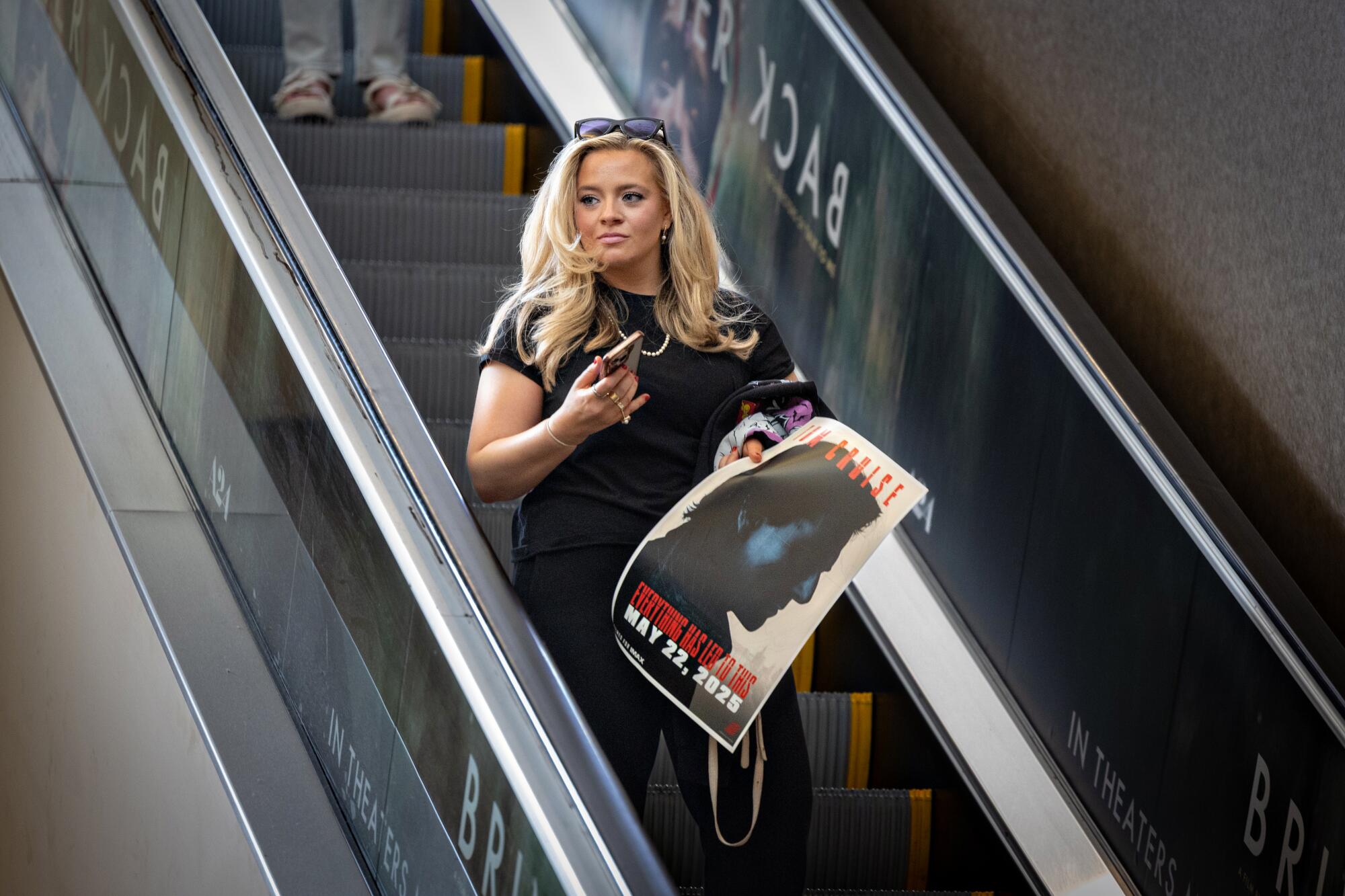‘Superman’ is back on the big screen. Can it revive DC?
He can outrun a train, hold up a collapsing tower on a fiery oil rig and fly around the world to turn back time. But Superman’s greatest challenge might just be saving the DC film franchise.
The Warner Bros.-owned superhero brand — one of Hollywood’s most important — has hit a rough patch in recent years.
Films such as 2023’s “Shazam! Fury of the Gods,” “The Flash” and last year’s “Joker: Folie à Deux” struggled at the box office. Despite owning a lucrative stable of well-known superheroes like Superman, Wonder Woman and Batman, the studio has failed to become a consistent competitor to Walt Disney Co.‘s Marvel Studios.
Now under the new leadership of filmmaker-producer pair James Gunn and Peter Safran, DC Studios is counting on its new “Superman” film, hitting theaters Thursday, to revive not only the Man of Steel series but the entire DC universe.
Choosing the flying Kryptonian refugee to kick-start DC’s new era was a risky bet for Gunn, who wrote and directed the new film.
Although Superman is recognizable all over the world, his aw-shucks demeanor and nearly limitless superpowers have made him a tough character to make relevant to today’s audiences. His global reputation, as an overgrown godlike Boy Scout spouting American ideals, for years made him less hip for modern viewers than his brooding billionaire vigilante counterpoint, Batman.
“DC has been playing catch-up with Marvel,” said Arlen Schumer, a comic book and pop culture historian. “They’ve given James Gunn the keys to the DC kingdom and said, ‘You’ve got to restore Superman. He’s our greatest icon, but nobody knows what to do with him. We think you know what to do with him.’”
“Superman” is expected to gross $130 million to $140 million in the U.S. and Canada in its opening weekend on a reported budget of about $225 million, according to analyst estimates. The movie received an 85% approval rating on aggregator Rotten Tomatoes. (Times critic Amy Nicholson said it wasn’t “quite the heart-soaring ‘Superman’ I wanted,” but enough to be “curious to explore where the saga takes him next.”)
Gunn’s efforts on “Superman” faced intense scrutiny online almost from the moment he started working on it. Fans and critics have picked apart the trailers, grousing about the heavy screen time for Krypto the Superdog (inspired by Gunn’s own dog, who is also a foot biter), or how actor David Corenswet, who plays the iconic superhero, is a relative unknown.
Warner Bros. itself is counting on “Superman” to continue a box office rebound stemming from a string of hits including “A Minecraft Movie,” “Sinners,” “Final Destination Bloodlines” and “F1.”
Shortly before its release, “Superman” came under fire from right-wing commentators, who criticized comments Gunn made to the Times of London about how Superman (created by a Jewish writer-artist team in the late 1930s) is an immigrant and that he is “the story of America.” He’s an alien from the planet Krypton, after all.
“I think this is a movie about kindness,” Gunn told Variety on Monday at the film’s Hollywood premiere in response to the backlash. “And I think that’s something everyone can relate to.”
That appeal is what Warner Bros. and DC Studios are counting on.
“You need a track record of success to build a brand,” said Paul Dergarabedian, senior media analyst at Comscore. “This is a monumental moment for DC with one of their biggest characters of all time and that’s very important to the box office, to the future of DC and to the perception of DC as a brand.”
DC Studios did not respond to requests for comment.
Superman returns
This summer’s Gunn-directed “Superman” is the first stand-alone film about the famous hero in more than a decade, following a history of dramatic ups and downs.
The 2013 blockbuster “Man of Steel,” directed by Zack Snyder and starring Henry Cavill, introduced a grittier, darker tone to the superhero’s story, including Superman’s controversial neck-snapping kill of a villain. “Man of Steel” received mixed reviews from critics, though it hauled in about $670 million in global box office revenue.
That was followed by 2016’s “Batman v. Superman: Dawn of Justice” with Cavill returning and Ben Affleck as Batman, which was panned by critics but made more than $874 million worldwide. Then came the even more reviled “Justice League” the following year, both a critical and commercial disaster for the studio. Ironically, Cavill’s portrayal of Superman was reclaimed by an unruly online fan base demanding that Warner Bros. #ReleaseTheSnyderCut, which it eventually did.
For many, the gold standard of Superman films was 1978’s “Superman,” starring Christopher Reeve and directed by Richard Donner.
Schumer remembers watching the sweeping wheatfield scene when Clark Kent says goodbye to his adoptive mother after his father’s death and embarks on his journey to learn who he truly is. Schumer marveled at the camera sweeping from the golden fields to the blue sky, symbolizing the fledgling Superman’s look toward the future. He ended up seeing the movie 10 times in theaters.
While 1980’s “Superman II” was still well-received, the third and fourth installments of the franchise “went off the rails” and became “campy,” Schumer said.
Unlike Marvel, which centralized control under president Kevin Feige, DC and Warner Bros. for years allowed Snyder’s vision to determine the direction of the film universe. Batman, on the other hand, has been successfully molded by multiple filmmakers (e.g. Christopher Nolan, Snyder and Matt Reeves), allowing new aspects of the character to shine through, Schumer said.
“DC Comics, [Superman] is your flagship property, but they’ve often never really treated it like their flagship property,” he said. “This affected the way DC made movies, versus Marvel.”
The studio has also been criticized for its lack of a cohesive vision and framework for its superhero universe, analysts said. The studio allowed its intellectual property to be splintered into parallel storylines, which became chaotic.
It’s why Gunn and Safran were installed as co-chairmen and co-chief executives of DC Studios in 2022.
Gunn seemed a surprising choice to co-run DC Studios. He started as a screenwriter at indie production house Troma Entertainment — known for B horror pictures — and eventually achieved global success in the superhero genre by directing Marvel’s “Guardians of the Galaxy,” beloved for its irreverent humor. He also had experience with DC, directing 2021’s “The Suicide Squad.”
With the pair at the helm, the goal was to standardize the superhero universe and kick-start a new epoch for the studio. “Superman” is intended to lead off for several upcoming DC movies, including “Supergirl,” starring Milly Alcock, “Clayface,” and “Dynamic Duo” about the Robins — Batman sidekicks Dick Grayson and Jason Todd.
“It’s a table setter,” said Shawn Robbins, director of movie analytics at Fandango and founder of site Box Office Theory. “It’s really intended to be the launching of an entirely new era for DC movies and where that might lead.”
Selling an American hero
But while Superman has generated toy sales, animated series and multiple movies, the character is hard to get right.
Schumer remembers how audiences laughed when Reeve’s Superman tells a scoffing Lois Lane that he was fighting for truth, justice and the American way in the 1978 film, at a time when America was reeling from the Watergate scandal and the end of the Vietnam War.
“This idea of truth, justice and the American way was deemed, even back then, hokey,” Schumer said. “And in a sense, it kind of still is.”
From the beginning, Superman has been a quintessential American immigrant story.
Two sons of Jewish immigrants, Jerry Siegel and Joe Shuster, introduced the superhero in 1938 in “Action Comics #1,” which told the tale of the alien, eventually known as Kal-El, who was sent to Earth to escape his dying planet. The comic was “an overnight smash success” that helped launch the comic book medium and the idea of the superhero, Schumer said.
In later stories, Superman’s Midwestern upbringing in Smallville, Kansas and his eventual move to the big city of Metropolis also mirrored the journeys many Americans were making during that time.
But today, there’s questions about whether Superman’s strong American symbolism will be a turnoff for global audiences, who have recently bristled at tariffs and trade policies enacted by President Trump.
“That assumption of Superman being a challenging character in some territories is a legitimate factor,” Robbins said. “What it’s going to come down to is the movie itself and how well it connects with international audiences.”
One advantage: The film snagged a coveted Imax slot — which can boost box office revenue and make a film more of an “event.”
The movie also comes as the once white-hot market for superhero films has cooled, both domestically and abroad. Even Marvel has recently seen lower box office results for its films — despite critical praise, “Thunderbolts*” grossed about $382 million worldwide on a budget of $180 million, paling in comparison to past films.
The potential for “Superman” overseas earnings could be big. Forecasts from entertainment industry analytics firm Cinelytic based on publicly available data found that “Superman” could make about $531 million in global box office revenue, with the top four most likely international markets in Britain, Germany, France and Australia.
Gunn brushed off questions about Superman’s archetypal American symbolism, telling the Times of London in an interview that his own market research found that international audiences viewed the Man of Steel as a global figure.
“He is a hero for the world,” he said in the interview.
But Superman has long-suffered from his lack of flaws and inability to really examine the American ideals he represents, said Annika Hagley, associate dean of the school of social and natural sciences at Roger Williams University in Rhode Island, who teaches a course on superheroes and politics.
Over time, Superman’s advocacy of America has remained constant, despite the evolving perception of the U.S. both at home and abroad, she said. That’s in contrast to his Marvel counterpart, the seemingly U.S.-centric Captain America, who evolved from fighting Nazis during World War II to questioning the morality of government surveillance, Hagley said.
While Superman’s immigrant backstory could lend itself to complex narratives about the treatment of newcomers in the U.S., DC has so far failed to evolve his story to address those questions, she said. He did, however, change his motto to the more borderless “truth, justice and a better tomorrow” in recent years.
As an immigrant in a post-9/11 era, “Superman is a security threat, but he’s also boring,” she said. “They’ve tried to make him less American, they tried to make him more alienated and it just hasn’t hit home for an audience in the way that the Marvel characters have.”
Gunn’s “Superman” does touch on America’s role in geopolitics. In a recent trailer for the film, Rachel Brosnahan’s Lois Lane interviews Corenswet’s Superman, questioning whether his involvement in a foreign country’s conflict and “seemingly acting as a representative of the United States will cause more problems around the world.”
“I wasn’t representing anybody except for me,” he interjects. “And doing good.”






